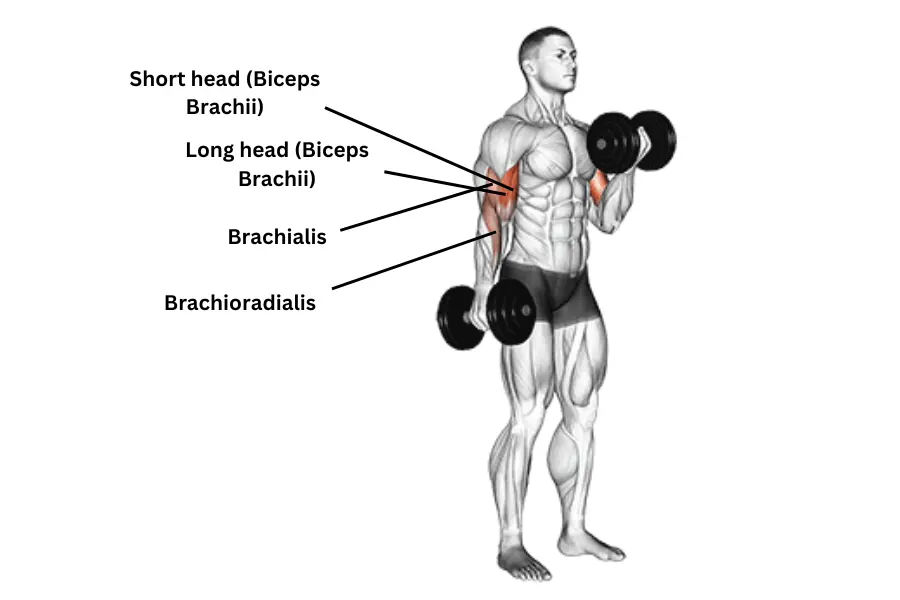Whether your goal is to build your biceps peak or strengthen your arm muscles, a pair of dumbbells can offer these benefits.
The dumbbell curl is a classic, well-known bicep exercise that promotes biceps development.
With numerous benefits, it has the potential to transform the appearance of your arms.
Following proper guidance and using the appropriate weight for your dumbbells makes this exercise easy to perform.
Dumbbell Curl Muscles Work
The dumbbell curls primary focus is on your biceps brachii (long and short heads) and brachialis, which are located in between your triceps and biceps.

These muscles are primarily activated during the upward phase of the curl. But when you hit the negative phase, your outer forearm reacts to the movement, further engaging your forearm muscles.
Benefits of the Dumbbell Curl
Why should you do dumbbell curls? Here are two benefits that will motivate you to perform this exercise for your biceps.
Bigger Arms
If it ain’t beefy, it ain’t worth flexing!
As both the upper and lower arms are engaged throughout both the lifting and lowering phases, they are consistently subjected to tension. This sustained tension is instrumental in promoting muscle growth, leading to significant development of the arms.
Balanced Muscle Growth
Compared to a barbell or any other piece of equipment, dumbbells stand out when it comes to balanced muscle development.
When you execute the dumbbell curl, you curl one arm at a time, allowing for independent movement and ensuring each arm follows the proper technique.
When each arm gets equal tension, the biceps and other muscles grow equally, rather than one arm getting somewhat more tension than the other.
How to Do Dumbbell Curl
Equipment: Pair of Dumbbells
Grip: Supinated/Neutral grip
Primary Muscle Work: Biceps
How To Do
- Stand up with your knees slightly bent and your feet shoulder-width apart for stability.
- Hold a dumbbell in each hand with your palms facing up, keeping your arms neutral.
- Begin by curling the dumbbells to the top, and remember to squeeze the biceps.
- Lower the dumbbells with control to the starting position and route your arms as you come down.
Dumbbell Curl Pro Tips
- Drop Sets. Push your muscles further by incorporating drop sets. Start with a challenging weight and perform a set of curls until failure. Then, immediately reduce the weight and continue curling for another set. This technique helps achieve maximum muscle activation.
- Don’t Neglect the Forearm. While the bicep is the main focus, remember to engage your forearms too. Adding a slight twist at the wrist at the top of the curl targets the brachioradialis, a forearm muscle crucial for grip strength and definition.
Common Mistakes
Mistakes can be overlooked at times, depending on the exercise. However, it’s important not to be someone who ignores mistakes that could easily be avoided.
Bending the Wrist
The wrist should always be straight; it shouldn’t be bent upward or downward while doing the curl.
Sometimes new lifters try to lift heavy dumbbells that are way out of their league. When they can’t lift them properly, they bend their wrists down to finish the set.
This might activate your biceps, but it won’t really help you grow your bicep the way it is supposed to grow. Plus, it could lead to a potential injury to your wrist and elbow.
Improper Elbow Positioning
Many of us may not realize it, but when our elbow isn’t in the right position during the exercise, it can engage different muscles instead of focusing on the biceps.
During the dumbbell curl, your elbows shouldn’t move forward or backward; they should be aligned with your shoulders.
Neutral Grip Matters
Ensure your hands are positioned neutrally, meaning they should be sideways, neither raised upwards nor downwards, at the starting position of the exercise.
If your hands are raised at the bottom and you start curling the dumbbell, you might risk injuring your wrist, and the exercise may become more challenging to perform.
Alternatives and Variations
- Barbell Curl
- Dumbbell Hammer Curl
- Machine Bicep Curl
- Dumbbell Preacher Curl
Barbell Curl
Switching from dumbbells to a barbell can be advantageous for many enthusiasts.
With a barbell, you can lift heavier weights, which helps strengthen your muscles and provides better biceps stimulation.
Barbell curls are simple and can be performed by anyone without needing complex knowledge.
Plus, if you have access to a barbell, you can easily do this exercise at home.
Dumbbell Hammer Curl
This exercise is different from the dumbbell curl, but except for the movement, everything is similar.
The execution of this exercise remains neutral, meaning you can’t move your hand sideways; it should maintain a supinated grip throughout.
All you need to perform this exercise is a pair of dumbbells, lifting one arm at a time. It primarily targets the biceps long head and brachialis, while also engaging the outer forearm muscle.
Machine Bicep Curl
The machine bicep curl offers an effective and less effortful alternative to the dumbbell curl.
By performing this exercise while seated and using the machine grip, it allows you to concentrate solely on your biceps without having to worry about maintaining proper form.
This exercise primarily targets the biceps and secondarily engages the forearm muscles.
Many lifters can benefit from incorporating this exercise into their routine.
Dumbbell Preacher Curl
Like the machine bicep curl, the preacher curl with a dumbbell allows you to target your biceps with focused contractions and minimal concern about form.
By using one hand at a time and then switching to the other, your biceps experience sustained tension throughout the movement, which may not be as pronounced when using a pair of dumbbells simultaneously.
This exercise is particularly effective for targeting the long head of the bicep and brachialis.
Featured Image Credit mihailomilovanovic/Getty Images